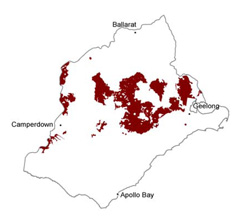6.1.3 Volcanic Western Plains with poorly developed drainage
|
The plains of the Newer Volcanic basalts that formed in the Late Pliocene and during the Pleistocene are generally characterised by thinner regolith development and poorly developed drainage. In these landscapes, flow boundaries are obvious, and corestones (‘floaters’) are often seen at the surface. Shallow drainage lines have developed, often along the boundaries of lava flows. Discontinuous drainage lines may end at ephemeral wetlands and swamps. Examples of this landform occur in the region from Warrambine to Armytage, with the best examples immediately north of the Wingeel Swamp. |  |
Soil-landform units
Soil-landform unit | Original unit ID | Unit description | Area (km2) |
84 | Low hills (east of Maude) | 2 | |
62 | Low hills (Mount Duneed) | 4 | |
109 | Undulating low basalt hills (Warncoort) | 5 | |
79 | Gently undulating plains (e.g. Berrybank) | 620 | |
81 | Stony rise, undulating plain with occasional steep hills (volcanic cones) (e.g. Warrambine) | 437 | |
86 | Undulating rises (e.g. Geringhap) | 321 | |
126 | Gently undulating rises (e.g. Mount Meningorot) | 5 | |
229 | Undulating rises and broad plains (Anakie East) | 166 | |
40 | Gently undulating plains (Anakie East) | 166 | |
132 | Gently undulating plains (Coragulac) | 28 | |
134 | Undulating rises (Nalangil) | 4 | |
143 | Gently undualting plains (east of Wingeel) | 57 | |
231 | Undulating rises (east of Lara) | 8 | |
25 | Gently undulating basalt plain (Cloven Hills() | 180 | |
72 | Undulating rises (south of Anakie() | 10 |


